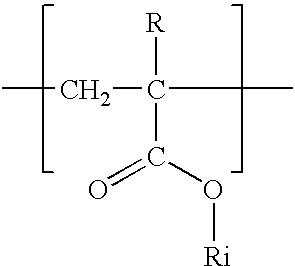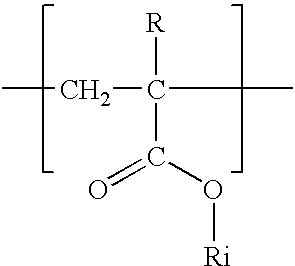Acrylic copolymers as additives for inhibiting paraffin deposit in crude oil, and compositions containing same
a technology of additives and copolymers, which is applied in the direction of organic dyes, etc., can solve the problems of high cost of processing, inability to always be carried out, and low dispersibility effect,
- Summary
- Abstract
- Description
- Claims
- Application Information
AI Technical Summary
Problems solved by technology
Method used
Image
Examples
example 1
A polymer (polymer A) was prepared constituted by:
73% by weight of "non U" C18-C22 acrylates;
15% by weight of "U" acrylates centred on C30; and
12% by weight of N-vinylpyrrolidone;
using the operating procedure described below:
321 g of "non U" C18 to C22 n-alkyl acrylates (Norsocryl.RTM. 18-22), 66 g of "U" acrylates centred on C30 with a mean molecular mass of 477 (Norsocryl.RTM. 121) and 52.8 g of N-vinylpyrrolidone in 360 g of an aromatic cut with boiling points centred on 190.degree. C. were introduced into a 1 liter reactor. The temperature of the reactor was raised to 40.degree. C. under vacuum, bubbling through nitrogen and maintained for 30 minutes, then to 115.degree. C., maintaining the nitrogen bubbling. 3 g of tertiobutyl perbenzoate was then added continuously over 1 h 30 minutes. 40 g of water and 0.3 g of tertiobutyl perbenzoate were then added. Heating was maintained for 3 additional hours with total reflux of the water. The water was then eliminated by distillation, t...
example 6
200 ppm of each of copolymers A to E described above (dissolved in xylene in a concentration of 37% by weight) was incorporated into different waxy crudes. The pour point of these solutions was determined in accordance with ASTM D-97.
By way of comparison, the pour point of these crudes with an addition of 400 ppm of ShellSWIM 5X.RTM. (a homopolymer of C18 to C22 alkyl acrylates sold in solution in xylene in a concentration of 50% by weight) sold by SHELL OIL COMPANY as a wax inhibitor was measured.
The results are shown in Table 2.
It can be seen that the dispersing compositions of the invention reduce the pour point of the crude better than the inhibiting compositions of the prior art.
example 7
A light condensate was treated that was characterized by a high wax content and a high tendency to form waxy deposits using the inhibiting compositions detailed in Examples 1 to 5.
To this end, 400 mg of each inhibiting composition was added per kg of condensate heated to 70.degree. C. and the anti-depositing power of the inhibiting compositions was evaluated using the following test (Cold Finger Test).
This test consists of weighing the deposit formed on the walls of a metal probe immersed in a crude oil, with or without additives. The temperature of the oil was generally taken as the temperature at the bottom of the well (temperature T1). Inside the probe, a fluid was circulating the temperature T2 of which was regulated, and corresponded to the climatic conditions to which lines or storage facilities are subjected.
The crude, contained in a 250 ml high sided flask, was homogenised continuously using a magnetic stirrer rotating at a rate of 250 rpm. This flask was placed in a thermos...
PUM
| Property | Measurement | Unit |
|---|---|---|
| boiling point | aaaaa | aaaaa |
| boiling points | aaaaa | aaaaa |
| polydispersity | aaaaa | aaaaa |
Abstract
Description
Claims
Application Information
 Login to View More
Login to View More - R&D
- Intellectual Property
- Life Sciences
- Materials
- Tech Scout
- Unparalleled Data Quality
- Higher Quality Content
- 60% Fewer Hallucinations
Browse by: Latest US Patents, China's latest patents, Technical Efficacy Thesaurus, Application Domain, Technology Topic, Popular Technical Reports.
© 2025 PatSnap. All rights reserved.Legal|Privacy policy|Modern Slavery Act Transparency Statement|Sitemap|About US| Contact US: help@patsnap.com



